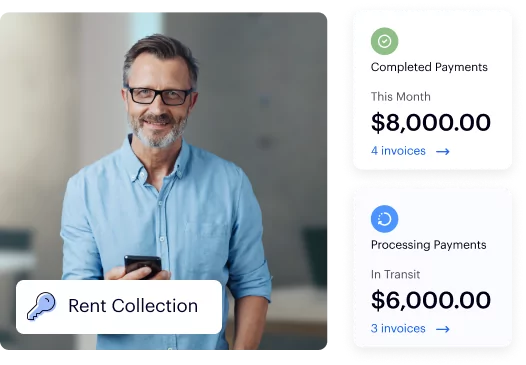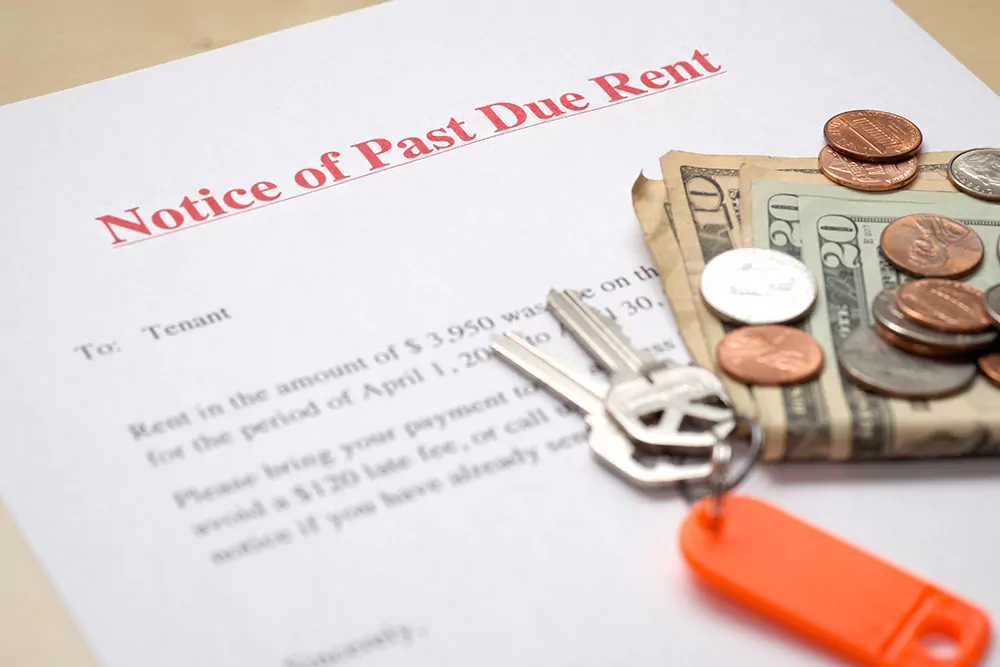Between late 2021 and late 2024, the typical past-due rent balance jumped 60%—from $2,000 to $3,200—putting landlords in a tough spot.
When a tenant offers a partial payment, it can feel like ‘something is better than nothing.’ After all, you’re avoiding bigger issues like late fees, eviction notices, or a vacant unit, right? But partial rent can sometimes make collecting the full amount even harder.
In this article, we’ll explain when accepting a partial rent payment makes sense and when it doesn’t. We’ll also cover how to avoid getting stuck in a cycle of late and incomplete payments.
Key takeaways
- Landlords can legally refuse partial payments if the lease requires full rent by the due date.
- Partial rent payments are usually considered late unless the lease allows them or a written agreement exists.
- Accepting partial rent can delay or cancel eviction in some states, forcing landlords to restart the process.
- Evictions cost an average of $3,500 and take months, so rejecting partial rent isn’t always the best option.
- Baselane’s online rent collection makes it easy for tenants to schedule one-time or automatic payments via ACH or card, increasing on-time payments in full.
What is partial rent payment?
A partial rent payment is when a tenant pays only a portion of the rent by the due date. For example, if rent is $1,500 and a tenant only pays $800, that’s a partial payment. The remaining $700 is still owed, and unless a formal agreement is in place, the tenant is technically still behind on rent.
During the COVID-19 pandemic in 2020, a study found that 87.6% of renter households in the U.S. made at least a partial rent payment for July. This shows how common the situation can be, especially in tough economic times.
Here are some common scenarios where tenants might offer rent split payments:
- Unexpected financial hardship: Job loss, medical bills, or other sudden expenses leave the tenant short on rent. Their rent may compete with other major monthly expenses.
- Bank issues or delayed deposits: A banking error or slow deposit means they can’t access their full funds immediately.
- Seasonal or fluctuating income: Gig workers, freelancers, or those with irregular paychecks may struggle to pay in full on a set schedule.
- Prior rent debt: The tenant still owes a balance from the previous month and can only afford part of the new rent.
- Attempt to avoid eviction: Some tenants may pay just enough to slow the eviction process and buy more time.
- Maintenance issues/Unlivable property condition: The tenant may withhold full rent due to unresolved maintenance problems, such as no heat, plumbing issues, or pest infestations.
Is partial rent payment considered late rent?
Yes, a partial rent payment is still considered late in most cases because the full amount wasn’t paid by the due date. Rent is only considered paid in full when the balance is covered (unless the lease states otherwise).
If the lease has a grace period (e.g., five days), the unpaid portion becomes officially late after that period ends. Some states have made it mandatory for landlords to set a grace period before charging late payments.
Landlords may offer waivers or written agreements to accept partial rent. If both parties agree to this in writing, the partial payment won’t be considered late as long as the tenant follows the agreed-upon schedule.
Should landlords accept partial rent payments?
If a tenant offers a partial rent payment, it might feel like a temporary fix, but it comes with risks. So, how do you decide whether to accept it?
Here’s an analysis to help you weigh your options when handling partial payments:
Compare the cost of eviction vs. what you're gaining
Evictions aren’t quick or cheap. If rejecting a partial payment means losing multiple months of rent while waiting for the court process, you might decide it’s better to work with the tenant.
On the other hand, if accepting partial rent just delays an inevitable eviction, it may not be worth it.
Consider state laws
In some states, like California, accepting any payment after starting an eviction nullifies the process, forcing you to start over.
In other states, a judge might see your acceptance of a partial payment as a sign that you agreed to a new arrangement, which could hurt your case.
Think about rent increases
If your rent has recently increased, accepting partial payment could introduce legal gray areas. A judge might interpret it as a waiver of the increase, forcing you to keep the old rate.
When planning a rent increase, calculate annual rent and notify tenants accordingly. Landlords should also know how to write a rent increase letter that complies with state laws and lease terms.
Because of these legal issues, many landlords choose to avoid partial payments altogether. However, legitimate hardships do happen, and sometimes, working with a tenant might be the better financial decision.
Pros & cons of accepting partial rent payments
| Pros | Cons |
|---|---|
| Provides some income and reduces risk of full non-payment | Encourages habitual late payments |
| Maintains cash flow, even if reduced | Increases administrative burden and tracking |
| Shows goodwill and can build tenant trust | Delays the eviction process if legal action is needed |
| Increases tenant retention if they recover financially | Legal risks—some states see it as waiving eviction rights |
| Avoids costly and time-consuming vacancy | Impacts cash flow, making it harder to cover expenses |
When to consider accepting partial payments
Every landlord prefers to collect full rent on time, but sometimes, accepting a partial payment makes sense.
Here are some situations where accepting a partial payment might be worth considering:
- Reliable tenant with a good history: It’s hard to maintain a healthy landlord-tenant relationship, as about 58% of renters say they have disliked at least one landlord they’ve had. If a tenant who usually pays in full struggles for the first time, working with them might make more sense rather than risk losing them.
- Tenant communicates and has a plan: If they reach out before the due date, explain their situation, and offer a timeline for full payment, they may just need a little flexibility.
- Slow rental season makes filling a unit harder: Rental demand slows in certain seasons (usually from October to December). If replacing the tenant would take months or require lowering the rent, keeping them might be better.
- Eviction costs more than waiting: Evictions take time and money. The average cost is $3,500, not including lost rent or legal fees. If the eviction process takes months and leaves you without income, accepting partial payment could help you recover some money while figuring out the best long-term solution.
- Legal restrictions could slow the eviction process: Some areas have eviction moratoriums or court backlogs that can stretch for months. If you’re in a state with legal hurdles, working with the tenant may be the most practical short-term option.
When not to accept partial payments
If any of the following apply, it’s usually best to decline the payment and stick to your lease terms.
- The tenant has a history of late or partial payments: If this isn’t the first time they’ve come up short, accepting another partial payment could encourage ongoing late payments. Approximately 42% of renters who incur a late fee are charged another late fee in the following month.
- You’ve already started the eviction process: In some states, accepting any rent after filing for eviction cancels the case, forcing you to start over. Even in states where it doesn’t automatically reset, a judge could view it as an agreement to let the tenant stay.
- Tenant refuses to communicate or provide a plan: If a tenant is consistently late and won’t explain when or how they’ll catch up, there’s little reason to believe things will improve.
- You’re raising the rent soon: If a rent increase is coming, accepting a partial payment could create legal complications. A judge might interpret it as an agreement to keep the old rent amount, making it harder to enforce the increase.
- You rely on full rent to cover property expenses: If your mortgage, taxes, insurance, or maintenance costs depend on full rent payments, accepting less could put your finances at risk.
What happens if a landlord accepts partial payment?
Depending on your lease agreement, state laws, and eviction rules, paying less than full rent could affect your ability to collect the remaining balance, charge late fees, or even proceed with an eviction.
Lease agreements
Check your lease before accepting a partial payment. Most leases require full rent by a set date and don’t allow partial payments.
If you accept one, get a written agreement stating:
- The remaining balance is due
- Deadline for full payment
- Late fees and how they accrue
- When a pay or quit notice will be issued
- When eviction may begin
Late fees
Many landlords charge late fees for rent that isn’t paid in full by the due date. But accepting a partial payment could create confusion about whether a late fee still applies.
Some states have strict rules about late fees, including:
- Limits on how much you can charge
- Required grace periods before late fees apply
- Restrictions on adding late fees after accepting a payment
Before taking partial rent, check your lease and local laws to make sure it won’t interfere with collecting late fees.
Eviction procedures
If a tenant is already behind on rent and you’ve started the eviction process, taking any payment could complicate or even cancel your case.
Every year, landlords in the U.S. file about 3.6 million evictions. Many cases take months to resolve, and accepting partial rent can slow things down even more.
In some states, the landlord may have to restart the eviction process if a tenant paid partial rent after an eviction notice was issued.
Even in states where accepting partial payment doesn’t legally stop an eviction, a judge could see it as proof that you allowed the tenant to stay, making it harder to win your case.
If you plan to proceed with an eviction, it’s usually best to refuse partial payments unless you’re sure it won’t affect your legal rights.
Steps to follow when accepting partial rent payments from a tenant
Here are the steps to protect your rights while organizing the payment process:
1. Review the lease agreement
Before accepting partial rent, check your lease agreement to see what it says about payments. Here are key questions to ask when reviewing the lease:
- Does the lease allow or prohibit partial payments?
- Does accepting partial rent affect late fees?
- Does the lease specify a grace period for late payments?
- Will accepting partial rent impact the eviction process?
If your lease does not allow them, you may need to create a written agreement before accepting any money.
2. Understand local laws
Landlord-tenant laws vary by state and city and can impact how you handle partial rent payments.
Some states have unique provisions. For example, in Florida, accepting partial rent after issuing a 3-day Notice to Pay or Quit can prevent eviction for that month’s rent, as it may be seen as waiving the right to enforce the notice.
In New York, landlords must give tenants a five-day written notice after rent is late before charging fees or starting eviction. The eviction process may be delayed or affected if you accept a partial payment.
Landlords must also follow Fair Housing laws when handling partial rent payments. These laws prevent discrimination and require landlords to treat all tenants fairly and consistently.
3. Communicate with the tenant
Let the tenant know if you allow partial payments and under what conditions. Make sure they understand paying rent in installments is a one-time exception, not a permanent arrangement.
4. Provide partial rent payment receipts
It’s important to provide a rent receipt whenever a tenant makes a payment (full or partial).
The best rent collection apps automatically track payments, send reminders, and generate landlord rent receipts. Keeping detailed records protects you in case of disputes. A rent roll template provides an organized way to monitor outstanding balances.
What to track when accepting partial rent:
- Date of payment
- Amount paid
- Remaining balance
- Payment method
- Late fees (if applicable)
- Written agreements
Send reminders as the due date for the remaining balance approaches. Rent collection software can help by sending alerts to tenants.
5. Evaluate long-term solutions
If a tenant struggles, negotiating rent for a temporary period may help. You might throw some of the following options to tenants:
- Offer a payment plan
- Encourage alternative rent assistance
- Consider cash-for-keys in extreme cases
- Adjust lease terms for better payment alignment (e.g., biweekly payments instead of monthly)
6. Protect your eviction rights
Some states allow landlords to accept partial rent and still proceed with eviction if they issue a Reservation of Rights Letter. This notice states:
- Accepting partial payment does not waive eviction rights
- The remaining balance is still due
- Eviction continues unless full payment is made by a deadline
A fileable rent ledger showing past-due payments can be used as evidence in eviction cases. However, some states, like California, automatically void evictions if any rent is accepted after filing, even with this letter. Other states have similar rules, requiring landlords to restart the process.
8 Tips for avoiding partial rent payments for landlords
Here are some tips to avoid partial rent payments for landlords:
1. Set clear expectations in the lease
A well-written lease leaves no room for confusion and ensures tenants understand that rent must be paid in full, on time, every month.
You can also add language prohibiting partial payments unless agreed upon in writing.
Here’s an example of a lease clause:
“Tenant agrees to pay the full rent amount of $__________ on or before the ___ day of each month. Partial payments will not be accepted unless approved in writing by the landlord. If the full rent amount is not received by the due date, it will be considered late, and late fees may apply.”
Tenants need to know what happens if they don’t pay on time. Your lease should outline the consequences of late or missing rent payments, such as late fees, eviction proceedings, and impact on future lease renewals.
2. Offer flexible payment options
81% of renters prefer to pay rent online. Offering digital payment methods increases the chances of receiving full rent on time. Many tenants prefer to pay rent with a credit card or ACH.
Some platforms also include mobile deposit options for checks, so tenants who prefer to pay by check can still do so without mailing delays or trips to the bank.
Some landlords allow tenants to split rent into 2 payments to better align with their pay schedules.
3. Encourage automatic payments
Tenants enrolled in automatic payments are less likely to pay late or make partial payments.
Avoid relying on cash or paper checks as primary payment methods. If tenants don’t have the full amount at the time of payment, they can get lost, delayed, or result in partial payments.
With Baselane’s online rent collection, tenants can easily set up auto-pay using ACH or a credit or debit card. Landlords also benefit from faster, more reliable payments without chasing tenants each month.
How Baselane auto-pay works:
- ACH Transfers: Tenants can pay rent directly from their bank account.
- $0 fee if deposited into a Baselane banking account.
- $2 fee if deposited into an external bank (fee can be charged to the tenant or landlord).
- Card Payments: Tenants can pay with a credit or debit card.
- 3.49% processing fee (charged to the tenant).
4. Enforce late fees
Charging late fees is one way landlords can collect unpaid rent without immediately resorting to eviction. As of June 2022, about 15% of renters (8.4 million Americans) were behind on rent, making it even more important for landlords to enforce clear payment rules.
Late fees range between 5% and 10% of the monthly rent. As of November 2024, the average late fee landlords charged was around $85. Some states set maximum late fees as a percentage of rent, while others have a flat dollar limit.
As a good practice, a late rent notice should be sent before applying penalties.
5. Provide rent reminders
Many late or partial rent payments happen simply because tenants forget. Automated rent reminders can significantly reduce missed payments by keeping rent deadlines top of mind.
These reminders also prevent tenants from spending money elsewhere before paying rent.
6. Screen tenants thoroughly
A strong screening process helps ensure tenants can afford rent and have a history of making payments on time.
With Baselane’s tenant screening, landlords get a comprehensive tenant background report that includes:
- Credit history
- Eviction records
- Criminal background check
- Income & identity verification
7. Check local rental assistance programs
As of recent data, 10.1 million people in 5.2 million American households rely on federal rental assistance to afford housing.
Many states and cities offer programs that provide emergency rental aid to tenants facing financial hardship. Here are some common programs:
- Emergency Rental Assistance Program (ERAP)
- Section 8 Housing Choice Voucher Program
- State Housing Finance Agency Rental Assistance
- Community Action Partnership (CAP) Rental Assistance
- Legal Aid Society Tenant Assistance Programs
- Local Housing Authority Rental Assistance Funds
8. Offer grace periods
Grace periods give tenants extra time to pay rent before late fees or penalties apply. In 2024, the Federal Housing Finance Agency (FHFA) introduced tenant protections for multifamily properties with federally backed mortgages, requiring landlords to provide at least a 5-day grace period for late rent payments.
Several states have their own mandatory grace periods, here are a few examples:
- Massachusetts: 30 days
- Maine: 15 days
- Connecticut: 9 days
- New York: 5 days
- Texas: 2 days
- Iowa: No mandatory grace period
Automate rent collection with Baselane
Here are some tips to avoid partial rent payments for landlords:
When tenants pay manually, there’s a higher chance they’ll forget, pay late, or send less than the full amount. Using an automated system like Baselane makes it easier for tenants to pay rent, reducing late and partial payments.
Baselane helps landlords collect full rent on time by automating payments, late fees, and reminders. The platform also offers tenant screening and digital leases so you can find and secure renters with a solid payment history and avoid issues from the start.
Plus, you can open checking and savings accounts to separate property expenses and security deposits, sync all your external bank accounts and cards, and automate bookkeeping directly in the platform, all without monthly fees or minimum balances.
Ready to increase on-time payments and stop chasing tenants for monthly rent? Sign up for free online rent collection today.
FAQs
In some states, accepting partial rent after an eviction notice resets the eviction process, meaning the landlord has to start over. In other states, landlords can still proceed with eviction if they provide proper notice and don't agree to a new payment arrangement.
Yes. Most landlords are not required to accept partial rent payments unless the lease specifically allows it. If the lease states that rent must be paid in full by a specific date, a landlord can legally refuse anything less than the full amount.
Accepting partial rent can have legal and financial consequences. In some states, it may void an eviction notice or create an implied agreement that the tenant can stay. It can also lead to habitual late payments, delayed cash flow, and difficulty enforcing lease terms.
Tenants cannot force a landlord to accept a partial payment unless the lease or local laws require it. In most cases, landlords can reject a partial payment and insist on full rent.
Half rent payments are typically considered insufficient unless the landlord agrees to accept half the rent. If full rent isn't paid by the due date, the remaining balance is still owed, and late fees may apply.









